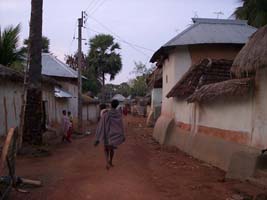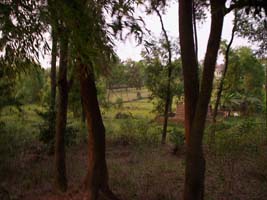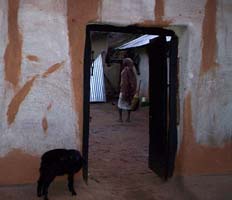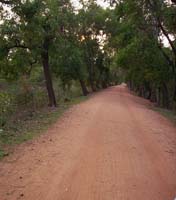
How rapturous, this dance of light on leaves
The wild storm in the shal forest makes my heart quiver.
Following the trail of the red road, folks dart to the haat
A little girl sits by the dusty path and spreads out her toys
These scenes that I bear witness to strike the cords of my heart’s veena.
(Rabindranath Tagore)
I listened to that song. As a child. As an adult. Somewhere along the line, I started singing it. To be inside a shalbon or Shorea Rubusta forest for real remained a distant dream for me. The opportunity to witness these forests finally materialized in 2007, when I began freelance work in Delhi and could pick my own holidays. Along with my mother, an alumni of the Visva-bharati University at Santiniketan, I headed to Bolpur, the city in West Bengal where the university — Rabindranath Tagore’s gift to learners of all stripes — is located. Vishwabharati Fast Passenger, the train we took from Kolkata’s Howrah station, sped past unending tracts of green towards Bolpur.
As we stepped down the station at Noon, a heavy downpour received us. “It’s been raining non-stop for the past two days, Didibhai,” Anwar, our rickshaw-wallah told me. I sighed. We had only three days to spend amidst this verdant, semi-rural landscape. Anwar promised to return to our lodge at 4 p.m. to take us on a rickshaw jaunt.
Shortly after we finished lunch—a filling platter of rice, lentils, jhuri aloo bhaja (finely julienned potato fries) and fish curry—the clock struck four. The rain had stopped. Anwar waited outside. “Come, Didibhai, I will show you a few things around here today. You have come such a long way, from Delhi. How can you miss gramchhara oi ranga matir poth, Khoai, or a Santhal village?”

To hear of Gramchhara oi ranga matir poth, the opening line of a song by Tagore, loosely translating to That ruddy road down the village makes my heart stray, intrigued me. Past visits to this place told me every road in this terrain was reddish brown, so I couldn’t discern what was special about witnessing such a road. The Santhal village called to my senses, though. I’d never seen a village, and the prospect of visiting one couldn’t be resisted. I jumped up to the rickshaw.
Born in Bolpur, Anwar had taken up his father’s trade and ridden his vehicle, wobbly with age, along the red roads for thirty years. Although his sun-stained skin had wrinkled, he still did a daily ten-hour shift of rickshaw ride through often steep and narrow roads. His facile, guide-like manner of introducing the spots, his soft speech, and a knowing smile—all revealed he was a pro and knew every nook and bend around these parts.
Soon we were past the main precincts of the Visva-bharati university, which Tagore founded, and its well-dispersed department buildings. The tranquil isolation of the place, coupled with the rickshaw’s see-saw rhythm, held me in a strange spell. The joy of wandering through a dirt road carelessly bracketed by haphazard vegetation had a raw quality to it, too living to translate into language. At one point, Anwar stopped his rickshaw. “Step down for a moment, Didibhai, and take a good look at this road. It was while walking here that Gurudeb got inspired to write gramchhara oi ranga matir poth.” I capered off the rickshaw, almost tripping over, lest I missed setting my foot on such a historic path. Only when we had extensively traveled with him did I know better than to take Anwar’s stock of trivia relating to Gurudeb—as Tagore is reverently called—as facts. I couldn’t say I didn’t enjoy them, though.
If Anwar were to be believed, barely a few steps down the road some more literary history had taken roots. He brought us to a giant banyan tree that looked like three trees merged into one. Twisted roots embraced its branches like a thousand gnarled snakes, even as the tangerine specks of a setting sun danced through those branches. This wasn’t any other banyan tree, Anwar told us. “You may want to take some photos of this one. Once, when Gurudeb was walking by this tree, he came across a potter carrying his ware on a bullock cart.” What followed from Anwar’s lips was the story of how Tagore elicited some family history from the potter, scribbling it all, within minutes, into a rhymed verse for children.

A bullock cart from the potter’s quarters
goes laden with pots and pitchers
The cart is driven by Bongshibadan
With him goes his nephew, Madan
(Rabindranath Tagore)
According to Anwar, Tagore had met Bongshibadan and Madan right by the landmark banyan tree. As the tale of Tagore’s genealogical research ended, the promise of Khoai, a special spot dear to the poet’s muse, began alluring us. As with the shalbon, I had become familiar with this place through Tagore’s poems and letters and from my mother’s reminiscences of her student days in Visva-bharati.
When Anwar’s rickshaw stopped a little later, I thought he wanted to catch his breath. Instead, it turned out Khoai had arrived. On looking around I saw more green vegetation and more ruddy dirt roads. What could be so special about this place? As my eyes searched for the answer, Ma and Anwar called my attention to a massive indentation in the ground. Tagore himself had named the area around this spectacular land formation “Khoai” because of the undulating laterite patterns.
The farmlands carved out of forests in the west
Merge with the indigo mist across the green horizon;
In between stands a Santhal village,
Enveloped with mango, date palm, tamarind, and jamun trees;
A long shadow-less path curves by the side
Like the intricate red border of a green sari.
…
There’s a hole at the northern end of this path,
The earth has eroded,
A silent upheaval of red stone—
Rusty black soil peeks out in places
like the head of Mahishasura.
In one corner, the earth has created small hills
with pelting rain,
Beneath them flows a nameless river of frolic.
(Rabindranath Tagore)
Apart from being a tourist attraction, this unusual geological formation is today the site of crafts and controversies. Every Saturday, local craftsmen bring their products for sale at a weekly fair initiated artist-activist, the late Shyamali Khastagir, Shyamalidi to locals and an ex-student of Visva-bharati. Along with a few others, she began this haat for the benefit of artisans who often lose out in today’s highly commercialized market atmosphere.
Anwar lamented the fact that we would return to Calcutta on a Friday; otherwise he would have taken us to the fair. Later, Shyamalidi would express to us her concerns about the fair’s longevity. Government backed efforts to build upscale heritage sites and housing complexes around Khoai were gaining ground. Not only would this pose a roadblock to artisans selling their crafts directly to customers, it would also disturb the area’s ecological balance.
News like that saddens old-timers like my mother. For this place isn’t just another lush land, but a way of life shaped by the manner in which the Tagore transformed this once-arid area into a living piece of poetry. According to Satyendra Basu in his book Trees of Santiniketan, the subsoil of Santiniketan at the time when Tagore started a school in the premises his father had purchased in 1863 was devoid of vegetable matter, with only a thin cover of top soil. Constant detrition caused this top soil to erode in many places, exposing the subsoil, which is what came to be known as Khoai.

Santiniketan, as envisaged and laid down by Tagore was a center of learning pivoted on freedom, individual expression, and harmony. It celebrated nature and its bonding with humans. To this day, classes are held under the shade of trees spread across the campus premises. The Nobel laureate remained close to the land and its people all through his life. In 1921, he brought a large manor house and the land surrounding it in Surul, three kilometres from Santiniketan, where he would set up Sriniketan with the objective of empowering villages to be self sufficient and for villagers to solve their own problems instead of external solutions being handed down to them.
Today, with the advancement of free market economy and political upheavals, however, many of Tagore’s ideas are being tested.
*
Anwar wound his rickshaw towards the promised Santhal village. As the sun began sinking, rising cricket calls stirred the air. We came across a couple of forests. Eucalyptus and Shonajhuri trees crowded the first one. Not far from it stood another forest. An expansive shalbon—tall trees with wide, spread-out leaves—surrounded us. The surrealism of the shadowy green cover overtook my senses. The shal leaves brushed delicately against my face as I tried to capture them in my camera. As a breeze blew, the members of this massive family of trees appeared to whisper to each other. These forests were part of the West Bengal forest department’s aforestration drive, Anwar told us.
A thin film of daylight clung about as we approached the Santhal village. Dusk soon overpowered that film and we walked inside the village. The setting felt more phantasmagorical than any place I had seen. This was almost like a model, straight out of a film set. Built entirely of mud and hay, the village houses were spotless. The emphatic crowing of hens and bleating of goats replaced the cricket buzz. At a distance, two cows cuddled fodder.
The Santhals are a hardworking tribe and the largest indigenous community in the Indian subcontinent. Close knit and peace loving, they rely on agriculture for subsistence. Peeking inside a hut, I saw some basic utensils — aluminum pots to cook rice, a few plates and glasses and earthen stoves. The walls had been plastered with cow dung cakes, precious fuel. Outside the thatched huts, groups of men smoked tobacco from hookahs and gossiped over card games. The womenfolk tended to household chores—drawing water from the well, gathering firewood,removing the dung cakes.
Having lived in Bengal for centuries now, Santhals speak both Bengali and Santhali, their indigenous language. Ma asked a couple of women if we could enter the huts to see how they look. They didn’t reply, just smiled. Anwar pleaded with them, but without much luck.

My mud brick home
Is slowly taking shape, workers fill the place
A little at a time they raise the walls
Their backs bared to the sun
Every now and then
The trains can be heard whistling afar;
The hours pass, the day draws to an end,
A bell rings where sky meets land
I sit and watch,
Hesitant my thoughts as I muse – this young girl
Who has for her own sake
Blossomed forth in body and soul
That easy feminine strength best expressed in the giving of herself
Tempered with the sweet serenity of compassion,
I have employed her, paying her for work –
Stealing the very strength that suffers insult at being priced
Using money to break her down
There she comes again, the Santhal girl, her basket filled with clay.
(The Santhal Girl, Rabindranath Tagore; Translation: Ruma Chakarvarti)
When Anwar pulled his rickshaw out of the village, a deepening darkness made it hard to see the surroundings. Once every few hundred meters, light would gleam through houses built right in the middle of woods. Most of these mud-concrete structures—stark yet creatively carved out—had been constructed by ex students and teachers of the Kala Bhavana, Visva-bharati’s art department. I envied them the opportunity to live here.
*
I wondered how Anwar rode the rickshaw through the darkness. When I asked him how he managed it on these uneven roads, he laughed and said, “Been at it for thirty years, Didibhai. The darkness is our friend, it never does us any harm.” The rickshaw plugged on ahead, students astride bicycles broke the stillness and the flicker of fireflies brought a warm aura to the night’s envelope. The fantastical trip came to an end in a few hours.
Did it, though? The Santhal girl’s shy grin, the smell of burning firewood, the shadow of the talking shal trees, and Anwar’s toothless smile would continue to flicker within me, interrupting the rush of urban chaos with a firefly’s sudden cadence.
[The End]
All translations are by Bhaswati Ghosh, unless otherwise specified.
Bhaswati Ghosh writes and translates fiction, non-fiction and poetry. Her first book of fiction is ‘Victory Colony, 1950’. Her first work of translation from Bengali into English is ‘My Days with Ramkinkar Baij’. Bhaswati’s writing has appeared in several literary journals, including Indian Express, Scroll, The Wire, Literary Shanghai, Cargo Literary, Pithead Chapel, Warscapes, and The Maynard. Bhaswati lives in Ontario, Canada and is an editor with The Woman Inc. She is currently working on a nonfiction book on New Delhi, India. Visit her at https://bhaswatighosh.com/
Subscribe to our newsletter To Recieve Updates
Join our newsletter to receive updates